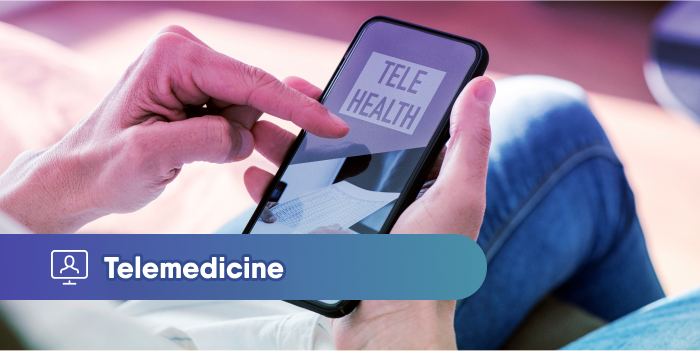What Is Telehealth Certification?
Telehealth or telemedicine became one of the most practical applications to use during the COVID-19 pandemic. Its popularity in the healthcare...

You may not believe it, but telehealth has been around longer than you may think. The idea of telehealth started in the late 1800s from an article where using a telephone to deliver care was mentioned to reduce office visits.
Telehealth is rapidly gaining popularity in recent years, especially among people who deal with chronic illnesses or live in remote areas. It might be difficult to imagine, but millions of people don't have access to a doctor's office. Telehealth makes healthcare available to anyone with internet access, regardless of their physical location.
Let's review the history of telehealth and how it has become essential to millions of Americans.
As mentioned above, telehealth has been around for more than a century. As soon as a new invention would show up, people would try to find different ways to utilize it. That's what happened when radios became common — everyone talked about how doctors could attend radio shows and consult their patients remotely.
In 1924, an illustration popped up in the Radio News magazine with the headline 'The Radio Doctor—Maybe!' The picture shows a doctor having a video call with their patient. Back then, it was merely a product of imagination. Little did they know that the image would become common practice less than a century later.
The inception of telemedicine dates back to 1948 when physicians began to transfer radiologic images via phone. The images traveled 24 miles from West Chester to Philadelphia. Having taken notice of this never-before-seen transmission, a Canadian radiologist started working on a teleradiology system just a few years later.
In the 1960s and 1970s, additional telemedicine applications emerged. The movement received massive support from the Department of Defense, NASA, and the U.S. Department of Health. The Department of Defense and the U.S. Department of Health then sponsored some teleradiology projects during the 1970s and 1980.
Each state has its own, slightly modified definitions of telehealth and telemedicine. For example, South Carolina defines telemedicine as the use of medical information about a patient exchanged from one site to another through electronic communications to provide medical care to a patient in circumstances in which face-to-face contact isn't necessary. Electronic communication uses interactive telecommunication equipment that typically includes audio and video equipment permitting two-way, real-time interactive communication between the patient and the physician or practitioner at the referring site. Telemedicine includes diagnostic, consultation, and treatment services.
However, Louisiana defines telemedicine as "rendering healthcare services when a physician or other licensed practitioner and a beneficiary are not in the same location."
Many states do not differentiate between telemedicine and telehealth. For this article, we'll use the two terms interchangeably. That said, it's important to keep in mind that telehealth is, in general, a more encompassing term. Telehealth may also include telemedicine and is primarily used to describe a wide range of healthcare services delivered remotely.
Another critical difference is that telemedicine always implies diagnosis and treatment, whereas telehealth refers to other modalities, such as remote patient monitoring, doctor-to-doctor communication, and medical staff education.
Telehealth's rapid growth has influenced the healthcare industry's large-scale adoption of telehealth services over the past months, ever since the COVID-19 outbreak. It has allowed medical practices to deliver a wide range of much-needed services to patients nationwide in an innovative, cost-effective manner.
Telehealth gives all citizens a unique opportunity to receive what we would consider a basic human need: healthcare. Knowing how many rural areas the U.S. alone has, it isn't surprising to see the rapid expansion of telehealth services.
A 2020 survey conducted by the American Medical Association notes that 79% of practitioners and hospitals are either partially or fully involved in telehealth. Nearly all Medicaid programs offer partial compensation for some telehealth services. Many argue that what Medicaid covers in telehealth services simply isn't enough, and the progression of telehealth in the United States is disappointingly slow.
To better understand Medicaid reimbursement for telemedicine, let's break it down:
If you're curious to see how private payers handle reimbursement, let's take a look:
The statistics show how rapidly telehealth's application and overall acceptance have increased. For example, based on the survey mentioned above, in 2018, only 25% of physicians used telehealth. However, only a couple of years later, in 2020, the percentage skyrocketed to over 79%.
Although telehealth has several drawbacks, cross-state is licensing is one of the most prominent. Each state has its own policies, and they vary greatly. For example, there are:
Telehealth benefits anyone that decides to participate in it — from hospitals and physicians to patients. If you're curious to learn more about this, let's see how different groups benefit from telemedicine.
The primary purpose of telemedicine and telehealth was to facilitate patients' access to healthcare. The benefits telehealth offers to patients include:
Telemedicine makes healthcare more convenient, eliminating many of the reasons some patients may avoid, cancel, or miss appointments.
Telehealth also comes with significant benefits for healthcare workers, so let's see what these benefits entail:
It is important to note that telehealth also functions as an outstanding business model for healthcare workers. They can choose how many patients they want to see a day and provide convenient access to medical care.
Critical Access Hospitals could use telehealth in a way that results in:
Ultimately, telehealth allows hospitals to serve a higher volume of patients while minimizing risks to staff and the costs associated with in-person care.
Telehealth has few downsides. The main disadvantages of telehealth are legal, regulatory, law, and policy issues stemming from the various telehealth policies in individual states.
For example, some of the most common challenges with telemedicine in the legal and regulatory fields are:
Apart from these legal issues, there aren't many other drawbacks. The other disadvantage of telehealth is staying up-to-date with technology and equipment.
The COVID-19 pandemic changed the way we think about and use telehealth. Telehealth was not a widely available option until the COVID-19 virus forced us all to stay at home and social distance when we had to go out. Now, providers offer telehealth services to keep themselves, their staff, and their patients safe from the spread of coronavirus and other illnesses.
Now that everyone sees the importance and the necessity of remote medical care first-hand, they realize the other benefits of telehealth. As a result, many patients and providers may opt for telehealth even after the pandemic ends.
Curogram is a HIPAA-compliant telemedicine and patient engagement platform designed specifically for healthcare professionals. In addition to secure telehealth software, Curogram includes:
Contact us today to learn more about how Curogram can help you implement a best-in-class telemedicine and patient engagement platform.

Telehealth or telemedicine became one of the most practical applications to use during the COVID-19 pandemic. Its popularity in the healthcare...

Telemedicine is growing rapidly and changing the healthcare landscape for the better. With many patients embracing the benefits of remote care, the...

Michigan is a state with precarious telemedicine and telehealth laws. While Michigan does have a telemedicine parity law and a telehealth law—the...